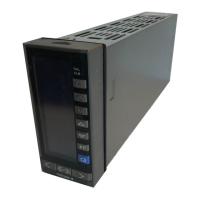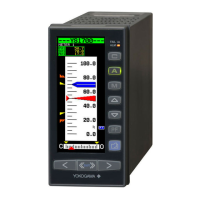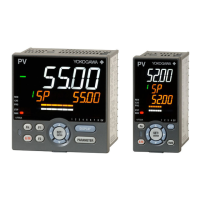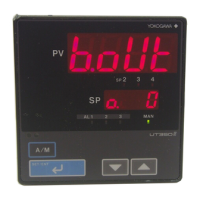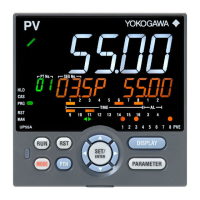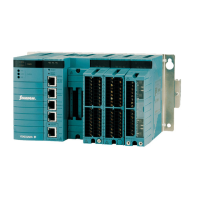26
IM 01B08B02-01EN
Monitoring and Control of Regular Operations (Operation Display)
Monitoring and Operating the ALARM Display
The ALARM Display collectively indicates detailed information when alarm(s) occurs. It allows the user to acknowledge unac-
knowledged alarms and events.
Tag number (1)
Display title (2)
Item title (3)
(4) Alam item
(5) Unacknowledged alarm marks
MV display (9)
(8) Software key function display
(7) Alarm lamp
(6) Operation status display
Figure 5.4
Table 5.13
No. in
Figure
Name Description
(1)
Tag number The tag number of the loop 1 is displayed.
(2)
Display title The title of the display being shown is indicated.
(3)
Item title
Alarms and events that have occurred or been generated are displayed on a type basis. They
are classified into the following four types:
Display Description
[PROCESS] Process alarms
[STC] STC alarms
[SYSTEM] System alarms
[EVENT] Event display
(4)
Alarm item
There are two types of display formats for alarm items as follows:
Red backlit display of items: An alarm(s) is currently being generated
Normal display of items: Indicates that an alarm(s) was generated in the past, but the situation
has now recovered
► Forcausesofalarmsthathaveoccurredandactionstobetaken:see“Troubleshooting”in
this manual.
The alarm items to be displayed are as follows:
Process Alarms
Display Description Display Description
[PH1] PV1 high limit alarm [PH2] PV2 high limit alarm
[PL1] PV1 low limit alarm [PL2] PV2 low limit alarm
[HH1] PV1 high-high limit alarm [HH2] PV2 high-high limit alarm
[LL1] PV1 low-low limit alarm [LL2] PV2 low-low limit alarm
[DL1] Deviation 1 alarm [DL2] Deviation 2 alarm
[VL1] PV1 velocity alarm [VL2] PV2 velocity alarm
STC Alarms
Display Description Display Description
[SYS-ALM] System alarm [PWRDWN] Power supply failure
[PVOVR] PV alarm [PBLMT] PB alarm
[MVLMT] MV alarm [TILMT] TI alarm
[OPERR] Operation failure [TDLMT] TD alarm
[IDERR] Identification impossible [RTALM] RT alarm
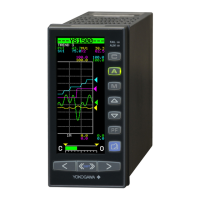
